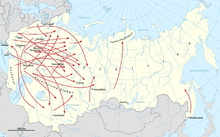
Back تهجير Arabic Məcburi yerdəyişmə Azerbaijani مجبوری کؤچکون AZB Прымусовае перасяленне Byelorussian Prisilno raseljavanje BS Nucené vysídlení Czech Vertreibung German Ανταλλαγή πληθυσμών Greek Deviga migrado Esperanto Migración forzosa Spanish
| Total population | |
|---|---|
| 108.4 million[1] (2022) | |
| Regions with significant populations | |
| Refugees | 34.6 million |
| Internally displaced people | 57.3 million |
| Asylum seekers | 2.9 million |
Forced displacement (also forced migration or forced relocation) is an involuntary or coerced movement of a person or people away from their home or home region. The UNHCR defines 'forced displacement' as follows: displaced "as a result of persecution, conflict, generalized violence or human rights violations".[2]
A forcibly displaced person may also be referred to as a "forced migrant", a "displaced person" (DP), or, if displaced within the home country, an "internally displaced person" (IDP). While some displaced persons may be considered as refugees, the latter term specifically refers to such displaced persons who are receiving legally-defined protection and are recognized as such by their country of residence and/or international organizations.

Forced displacement has gained attention in international discussions and policy making since the European migrant crisis. This has since resulted in a greater consideration of the impacts of forced migration on affected regions outside Europe. Various international, regional, and local organizations are developing and implementing approaches to both prevent and mitigate the impact of forced migration in the previous home regions as well as the receiving or destination regions.[3][4][5] Additionally, some collaboration efforts are made to gather evidence in order to seek prosecution of those involved in causing events of human-made forced migration.[6] An estimated 100 million people around the world were forcibly displaced by the end of 2022, with the majority coming from the Global South.[7][8]

- ^ "Global Trends Report 2022" (PDF). UNHCR global.
- ^ "UNHCR Global Trends –Forced Displacement in 2014". UNHCR. 18 June 2015. Retrieved 25 May 2020.
- ^ High Commissioner's Dialogue on the Root Causes of Forced Displacement (Report). doi:10.1163/2210-7975_hrd-9811-2015004.
- ^ Cone, Jason, And Marc Bosch Bonacasa. 2018. “Invisible War: Central America’s Forgotten Humanitarian Crisis.” Brown Journal of World Affairs 24 (2): 225–39.
- ^ "Mission, Vision and Values | U.S. Agency for International Development". www.usaid.gov. 2018-02-16. Archived from the original on 2020-02-02. Retrieved 2019-10-24.
- ^ Guido Acquaviva (June 2011). "Legal and Protection Policy Research Series: Forced Displacement and International Crimes" (PDF). UNHCR. Retrieved 11 April 2018.
- ^ "UNHCR: A record 100 million people forcibly displaced worldwide". UN News. 23 May 2022.
- ^ "Number of displaced people passes 100m for the first time, says UN". The Guardian. 23 May 2022.
© MMXXIII Rich X Search. We shall prevail. All rights reserved. Rich X Search